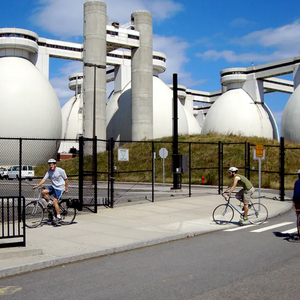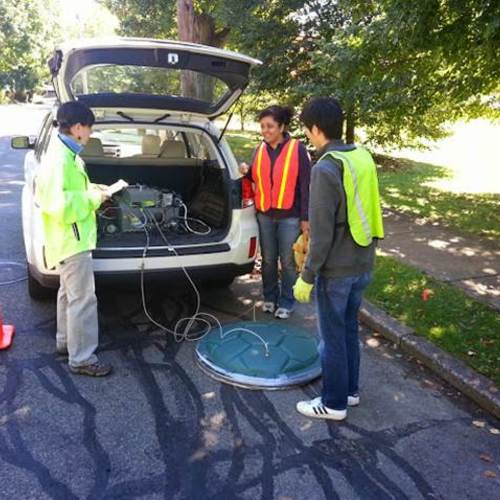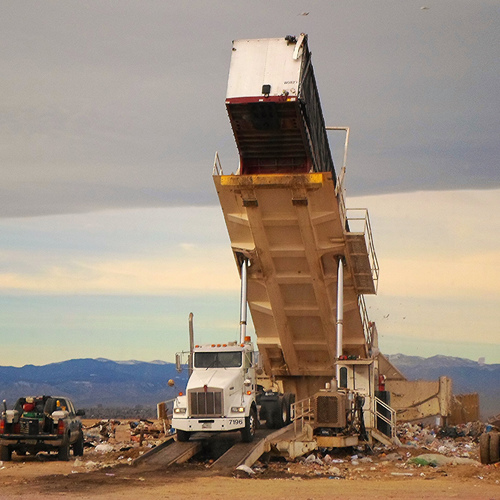In last week’s column I examined a fairly unusual local power source: the Northfield Mountain pumped hydropower system, which is used for “storing” electricity—by pumping water uphill. This week we’ll take a look at a very different power-generation system that’s even closer to home: the landfill gas power plant at the Windham Solid Waste Management District (WSWMD) facility on Ferry Road.
More than a quarter-century ago, in 1982, the nation’s first landfill gas power generation system went online—right here in Brattleboro. Our facility wasn’t the first in which landfill gas was collected and used, but earlier systems burned the gas directly as a source of heat. The Brattleboro system was the first that burned landfill gas in a generator to produce electricity that was fed into the power grid.
Before I describe the Brattleboro system, here’s a little background on landfill gas. Municipal solid waste contains a lot of organic matter—about 65% according to U.S. Environmental Protection Agency (2003 data), including paper (35.2%), food waste (11.7%), yard trimmings (12.1%), and wood (5.8%). This organic matter, when we dump it somewhere, gradually breaks down due to action of bacteria. If the material is aerated (as in a compost pile), oxygen-loving (aerobic) bacteria will decompose it, producing water vapor and carbon dioxide. But if oxygen is not present (as is the case in landfills), “anaerobic” bacteria decompose the organic matter producing methane, carbon dioxide, water vapor, and trace compounds like hydrogen sulfide. (These gases account for the unpleasant odor coming from dumps.) The methane component of the landfill gas (about 50%) has significant energy content that we can capture.
Capturing and burning landfill gas makes sense for two reasons: first it’s a source of energy that can reduce our need for fossil fuels. Second—and probably even more important—if we capture and burn that methane we prevent it from escaping into the atmosphere, where it becomes a powerful greenhouse gas. In fact, each molecule of methane is approximately 20 times as potent a greenhouse gas as a molecule of carbon dioxide. To prevent the escape of methane into the atmosphere, EPA now requires most landfills to capture and burn the methane—this also reduces the risk of explosions, which used to be relatively frequent at landfills. The methane-rich gas is most commonly collected by sticking plastic pipes into the landfill and using a vacuum to suck the gas out. The landfill gas can be burned (or flared) by attaching spark igniters to the top of vertical standpipes. If the gas is being collected for use, a network of pipes carries the gas to a generator.
I toured the Brattleboro landfill in the spring of 2007, when my daughter was working on a high school project about landfill gas. I had long known of this power generation system, but had never gotten a first-hand look at it. (Just a month before our visit, two of the facility’s remaining three reciprocating-engine generators, each rated at 80 kW, had been destroyed by fire, but the remaining 250-kW unit had just been repaired and was operating.)
Brattleboro’s power generation system was developed in 1982 by Louis Audette and Lawrence (“Stub”) Thomas, who was then the owner of the landfill. Howard Katz and several investors owned the system for most of its productive life, and Katz sold it a year-and-a-half ago to another investor, who defaulted on payments to WSWMD—resulting in the District cutting off gas to the plant last month.
Negotiations are underway for pack payments and a likely transfer of ownership to the District. In addition to the collection of landfill gas for power generation, some flares are used at the landfill where collection isn’t practical.
The Brattleboro facility has used a number of different generators over the years, and there were sometimes multiple generators operating. All four of the original 80 kW units failed or burned, as did one of the two 250 kW units installed in the ’90s. At its peak production, from about 1999 to 2003, the system produced about 800 kW of electricity. But as landfills age they produce less and less gas, and ours is well along in this period of declining production. Thus, when two of the generators were destroyed by fire in April 2007, they were not replaced, leaving just one 250-kW generator. During the past two years, according to WSWMD executive director George Murray, the output has averaged 150 – 180 kW.
The District recently received a $25,000 grant for a feasibility study to replace the aging 250-kW generator with two 135-kW combined heat and power (CHP) generators. These new generators would produce both electricity that would flow into the power grid and thermal energy that would be used to heat the District buildings.
Weekly Newsletter
Get building science and energy efficiency advice, plus special offers, in your inbox.















0 Comments
Log in or create an account to post a comment.
Sign up Log in